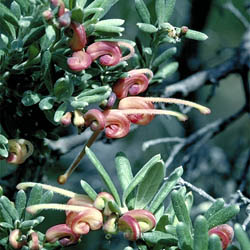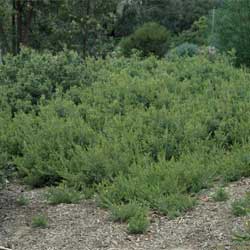Grevillea 'Little Thicket'
 |
 |
Also called Grevillea obtusiflora 'Little Thicket'
Grevillea 'Little Thicket' nom. cult.
The plant described here as Grevillea 'Little Thicket' was originally thought to be a form of Grevillea obtusiflora. Botanists now consider that it may be a natural hybrid between G. arenaria subsp. arenaria and G. lanigera. More taxonomic work is needed to define more precisely this interesting plant. Should the plant eventually receive a separate botanical name the cultivar name will lapse.
Grevillea 'Little Thicket' is a naturally occurring cultivar (a cultivated variety) that differs from its presumed parents in its suckering habit. It has been registered as a cultivar because it has considerable potential for use in landscaping. This plant was originally discovered near Braidwood in New South Wales and has been in cultivation at the Australian National Botanic Gardens since 1972. The cultivar rarely exceeds 0.5 m high with a diameter of 1 m; however, due to the suckering habit, dense thickets are formed. Suckers appear along surface roots at intervals of 30 cm and up to 5 m from the original plant.
The flowers on the cultivar are produced in small terminal clusters and are generally insignificant, often aborting at an early stage. Flowers are about 8 mm long and pale yellow with a red tinge, and the yellow styles are up to 20 mm in length. The leaves, up to 18 mm long and 3 mm wide, are dark green on the upper surface with the margins rolled under. The under-surface is covered with dense silky hairs.
Propagation is by cuttings, (essential to preserve the prostrate habit) and may be taken at any time of the year, although those taken in late spring or early summer have proved most successful
The plant is tolerant of a range of soil types and moisture conditions. It has performed best in moist, sandy loams and silts, but satisfactory growth has also been noted in drier clay soils. No damage has been observed after a sustained dry period.
Because of the suckering habit and subsequent dense growth Grevillea 'Little Thicket' has exciting prospects in horticulture, particularly in the landscaping of large areas. This type of growth can be valuable around buildings, carparks, embankments and roadside cuttings. The low, spreading habit has advantages in being unobtrusive yet maintaining an orderly appearance. The suckering habit allows rapid regeneration of damaged areas. As a ground cover it is successful in suppressing weed growth. Its suckering habit also reduces the density of initial planting, resulting in cost savings. The spreading roots and suckering habit also offer advantages in bank stabilisation, particularly in roadside cuttings.
In the home garden G. 'Little Thicket' could be used as a ground cover, trimmed into a low hedge or as a bank stabiliser. No pests or diseases have been noted on the plant and it is frost resistant.
Text by Ron Jackson, ANBG(1980)
Name meaning: Grevillea 'Little Thicket'Grevillea - after C.F. Greville (1749-1809), an English patron of botany; 'thicket' - meaning a dense growth of trees or shrubs. |
![An Australian Government Initiative [logo]](/images/austgovt_brown_90px.gif)

